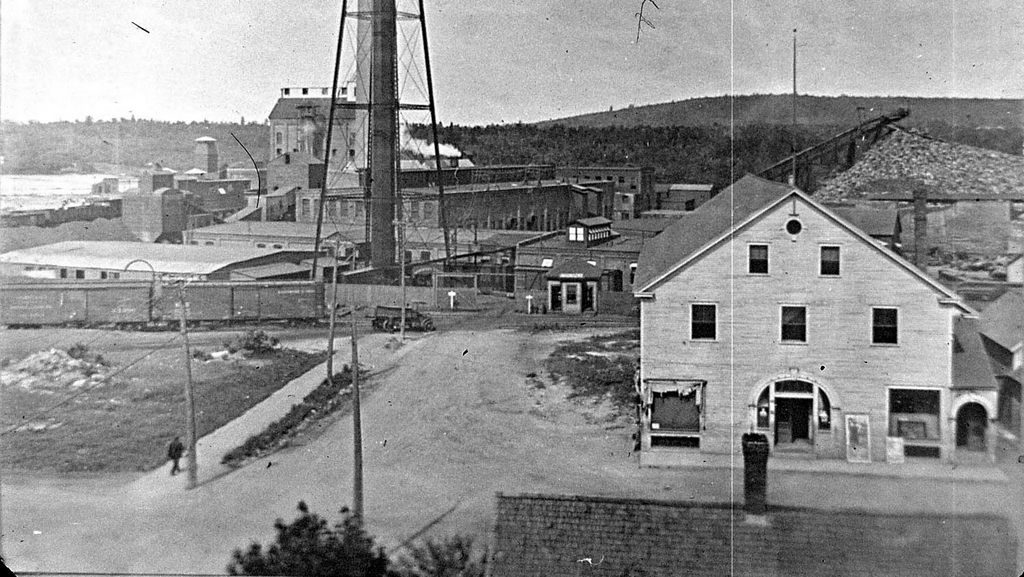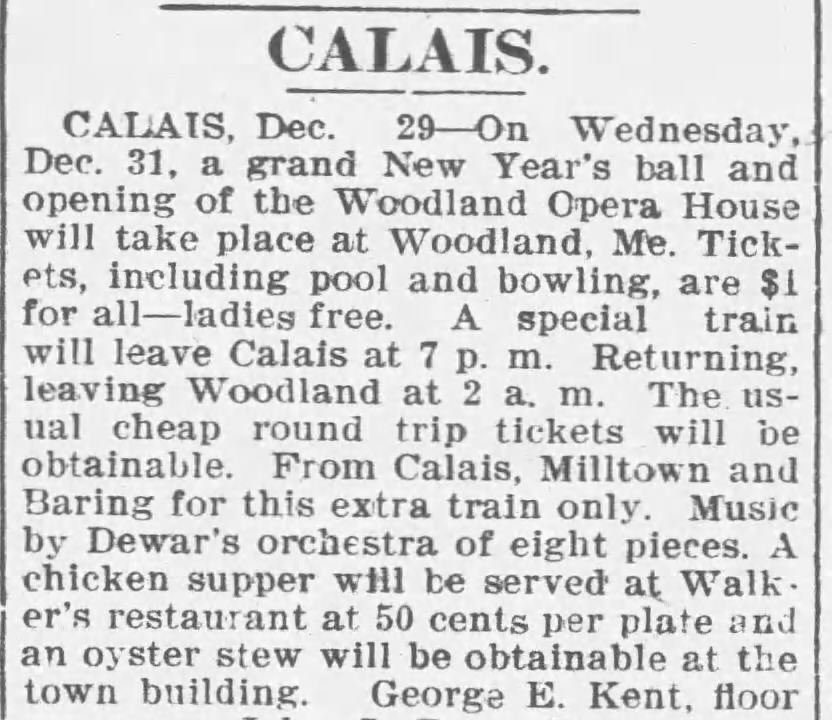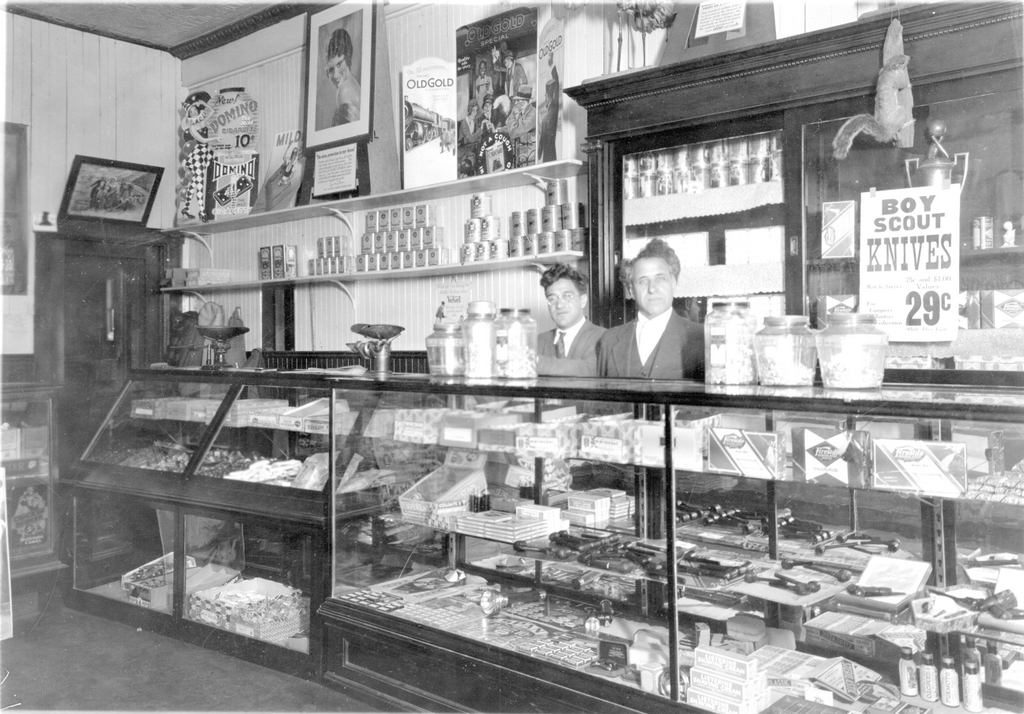
Some old photos contain a lot of history, often history we have forgotten over the years. Above is one of them. It was provided by Mike Foggia whose grandfather, also Michael Foggia, is to the far right in the white jacket. These fellows, celebrating with beer and cigars an unknown event, are all Italians, some of the hundreds of Italian immigrant laborers who built the Woodland mill back in 1905-06. Had it not been for immigrants like these there would have been no paper mill in Woodland, no steel mills in Pittsburgh and no railroads to carry the iron horses responsible for the great American economic miracle.

Michael Foggia came from Italy in 1899 at the age of sixteen, when it was necessary for minors to have a guardian appointed before entering this country. He worked in several places in Maine and finally entered the employ of Charles Murray, a labor contractor who recruited Italian immigrants to work on large building projects in northern and Downeast Maine. Foggia came to Woodland in 1905 from Perry where he had been working for Murray on the branch of the railroad being run into Eastport and erected the bakery which was to furnish the bread for the laborers employed in the construction of the Woodland Mill. He lived in Woodland the rest of his life. Mike went back to Italy for a visit in 1906 and returned with his bride Amalia Adocmo. They built an attractive home on the corner of Second Avenue and Broadway in 1916.
He and Charlie Murray, also an Italian immigrant, became business associates.

Their primary business venture was the Woodland Opera House, which can be seen above in its very early days just outside the main gate to the mill. It was only fitting that Woodland should have an Opera House as the Woodland mill was built by 1000 opera-loving Italian immigrants. Calais, a town of many Scots, English, Swedes, Armenians and Russian immigrants who knew little about opera, had had an “Opera House” since the 1870s, so it is only natural the first place of entertainment built in Woodland would be an Opera House. We’re unsure how much “opera” was performed in Woodland. In Calais there was some opera performed on the stage by both professional and school groups. In actuality “Opera House” seemed, in those days, to mean more a venue for diverse entertainment, including, vaudeville, plays, dancing and later, moving pictures.
An article about the Woodland Opera House dated May 1, 1958, provides a brief history of the “Woodland Opera House”:
In 1907 and only two years from the time Woodland was a forested, largely uninhabited wilderness, Charles Murray, an immigrant from Italy, built the Woodland Opera House to provide the then-boom town a venue for entertainment. He made his countryman, Michael Foggia, its manager and for over half a century the “Opera House” was the social center of the town. Located just outside the mill gate, it featured vaudeville, plays, dancing and even prize fights in the early years. By the roaring twenties moving pictures were the central attraction and, in the thirties, bowling alleys were added. It hosted high school graduations and school plays in the days Woodland’s school had no gym. Mike Foggia, who soon bought the building, opened a store on the first floor which became known for its fresh Italian bread. The business closed in the late 50s and the building was razed. The site now provides parking for the mill.

When the Opera House was dedicated on December 31st, 1907, a special train brought people from Calais to attend the “Grand Ball” which was the featured event at the ceremonies.

The Opera House was plagued by fires over the years, but Mike always built back better.

His store was on the ground floor and in addition to the bakery which supplied the town with Italian bread, it was always well stocked for the mill traffic.

When rebuilding in the 1930s, he added sufficient space for a first-rate movie theater which though a costly venture at the time was, he apparently felt, needed to provide the community with a complete entertainment venue.
Michael Foggia retired in 1958 and his achievements were praised in a 1958 newspaper article.
Woodland January 28, 1958
The coming of Spring, one of the many in the life of 76-year-old Michael Foggia, will ring down the curtain on a story of American business enterprise in which the principal is a stout-hearted son of Italy who made good in the best tradition of New World immigrants.
Foggia came to Woodland in 1905 when the first land-clearing operations for the construction of the St. Croix Paper Company mills began and found plenty of opportunity for work. He had landed in Boston after leaving his home in Vegliaturo, Italy, where he was born in 1882.
OPERATED CAMPS
In company with Charles Murray, who later became a prominent eastern Maine businessman, Foggia operated camps and help handle supplies for 800 or more other wood laborers in the vicinity.
Later as construction ended and mill operations began, Foggia and Murray engaged in business in the new industrial community in a building which Foggia later rented and then purchased.
Romance entered the picture in the midst of all the strenuous business activity, too, and like many of his countrymen who contributed to the growth of American industry Foggia found time to return to Italy. He married Amalia Adocmo in 1908. They returned to Woodland, later to be joined by his mother, Mrs. Rosie Foggia.
Other business enterprises followed including the Woodland Opera House. The venture was later acquired by the paper company, but later Foggia took over again and staked thousands of dollars on the then new talking pictures. Twice fire swept the theater but twice the stout-hearted rebuilt it, meanwhile operating bowling alleys, a soft drink and confectionary store and a lunch and refreshment stand for employees of the mill.
It is the mill refreshment stand he will relinquish into other hands come spring, when he seeks retirement from a life of hard work.
There are family members to share the retirement plans, all of whom are active responsible citizens. A son, Frank Foggia, is town manager in Baileyville, the town where the paper mill community of Woodland is located. Louis lives in Chelsea Massachusetts, Amedio is at Portland and a fourth son is associated with his father here.
Michael Foggia may retire from strenuous business in a short time but his fellow townsmen will be excused from doubting if his thoughts will ever stray far from the prosperous community he helped to build and which was, when he first saw it, virtually a wilderness.
Michael C. Foggia died at the Calais Hospital in May of 1965 survived by his wife and several children.

We do have to add a word about Mike’s business partner, Charlie Murray, who was a very interesting character. Born in 1874 in Italy to a Scottish father and Italian mother in 1874 he emigrated to the United States in 1886. He became a labor contractor who, according to Davis’ history of the St. Croix Valley, provided laborers to the building of mills and railroads in Eastern Maine and had quite a reputation for toughness.
From Davis’ history of the St. Croix Valley:
The company (Woodland Mill) took over the extensive timberland holdings of F. H. Todd and the power site at Sprague’s’ Falls on the American side five miles above Baring which had also belonged to him. During the next year a large dam and a pulp and paper mill were built at a cost of about $500,000. The company also put up clusters of drab little houses for workers, many of whom were Italian contract laborers. Some of these poor wretches tried to flee, but usually they were caught by Charles Murray, the hard-boiled labor contractor who supplied them.
Murray married Mary Willis of Perry in 1898 and relocated to Woodland while the Mill was being built. It appears Mike Foggia may have been one of those “poor wretches” Charlie had recruited to work at the mill. After selling his business interests to Mike Murray moved to Bangor where he was very successful, living in 1930 in the very upscale West Broadway section of Bangor. He died in December 1951 at his winter home in Florida. His obituary describes him as a “retired railroad construction contractor” and as “a member of the Lewey’s Island Lodge of F&AM at Princeton, Maine and of Scottish Rite and Shrine.” He was survived by his wife Mary Jane Murray and several children and was buried in Bangor.
